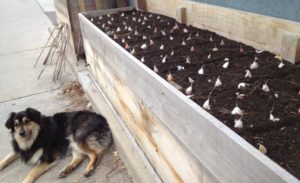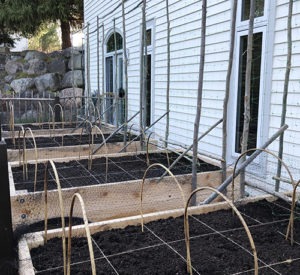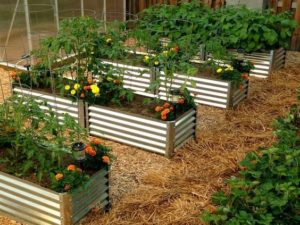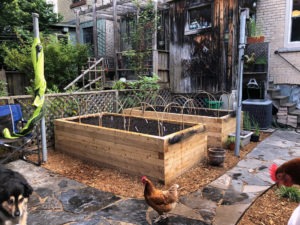Why Garden in Raised Beds?

There are loads of reasons to not garden, and trust me, we’ve heard them all. But honestly, few are insurmountable. Frequently, a raised garden bed is the answer. From bad backs, to lack of space, to poor soil, to critters, to not wanting to sacrifice the flower bed, raised garden beds offer solutions to many of garden-life’s problems.
There are near endless shapes and sizes of raised beds that can be made from all sorts of different material – stone, plastics, steel, shipping pallets for the do-it-yourselfer, a variety of woods, and yes, even bales of straw.
For this post, we’ll stick with the more common styles: Wood, steel, and stone, as we have a look at the pros and cons of each. First, though, why bother with raised beds at all?
Why Raised Beds?
#1. Raised beds are easy to work with
Our short list starts with how easy raised beds are to work. Being a back-pain suffer myself, raising the garden up by a couple feet not only reduces the amount of bending needed to access the soil, but also garden bed walls offer us a place to plant our bums while we garden. Two beds placed in the right proximity to one another allows us to sit on one bed while working the other. Personally, I find that taking a knee is a really comfortable way to work the garden, allowing me to keep my back straight while doing so.
#2 Raised beds help with plant growth
Reason #2, and perhaps my favourite, is how raised beds help with plant growth. As a rule, the soil in which plants are to be grown should never be walked on. The weight compacts the soil, making it more difficult for roots to grow deep. Compacted soil forces roots to grow laterally instead of vertically. When they grow laterally, they compete for water and nutrients with neighbouring plants. Raised beds never get walked on (or shouldn’t, at least), and so the soil stays loose and porous, allowing roots to grow in a more vertical pattern – nice and deep – reducing competition between plants and allowing more plants to be placed closer together, in a smaller space. Vertical growth also leads to a stronger root system. So a ripple effect of related benefits here.
#3 Raised Beds are organized and contained

Raised beds are easy to track year to year with your planting plan, especially if you use the Square Foot Gardening technique. Essentially, Square Foot Gardening is a system by which the garden area is divided into a grid of square feet, and planted accordingly – one tomato plant every other square foot, 16 radishes per square foot, and so on. So you can already see how easy it will be to keep records from year to year, helping with your crop rotation and succession planting plans. Additionally, raised beds help you to keep the garden neat and tidy. Although it can be nice to integrate your edibles with your ornamental plants, some people prefer to keep them discrete from one another, and raised beds certainly help to do that.
#4 Raised beds have excellent drainage
Water always flows downhill. Thanks, gravity, for always being the same. In the raised bed world, that means that over-watering is a near impossibility. Combined with loose and porous soil, the above-grade height of the bed means that excess water will always find its way to the lower ground surrounding the beds. So, better drainage.
#5 Raised beds let you start gardening weed-free, with an earlier start
When you install a new raised bed, you’ll likely be purchasing fresh triple mix soil that should be weed and seed free. So if you’ve got weed issues, this is an awesome way to get a fresh start. Additionally, by putting clear plastic over your frozen soil in early spring, you can defrost the soil within a couple weeks, allowing you an extra-early start to your planting. Not very successful with in-ground gardens, the soil in raised beds is isolated from surrounding frozen ground, allowing it to thaw much more efficiently. Leave your heat lovers until late May, but in April, carry on with radish, spinach, lettuces, chard, kale, and many others.
What kind of Raised Bed should I get?
As mentioned previously, raised beds can be made from a wide variety of materials.
| Steel Raised Beds
|
Stone Raised Beds
|
Wooden Raised Beds |
Steel beds are becoming increasingly popular, and in fact, BUFCO is looking forward to offering a version as early as this spring. More and more, we’re seeing versions that are colourful and offer a variety of shapes, sizes and heights. Prices are reasonable, and installation is easy. One problem with steel beds is that they are very temperature sensitive, which plant roots do not like. Steel with fluctuate quickly with the ambient temperature, heating and cooling soil and plant roots in a too-efficient way. Plus, the thin walls of steel beds do not offer a comfortable seat when one is desired.
Stone beds have a lot of really beautiful looks and can be designed in a wide variety of ways – different looks for different aesthetics. They can be expensive and labour intensive, especially if you’re not hiring a contractor. It’s a lot of weight to move about.

As with steel, stone beds are also lousy insulators. Stone is slower to react than steel, but react it does, also messing with soil temperatures. Plant roots thrive with consistent soil temperatures, so poor insulation and fluctuating temperatures are not the best.
Ever tried to put a screw through stone? I have, and I can tell you, it ain’t easy. When adding elements to your garden such as a trellis, it’s nice to be able to secure it to the garden bed structure. This is especially true in areas where there are high winds, and/or if you’re trellising something weighty like melons, and even more so when embedding trellises in lovely loose, un-compacted soil. Steel and stone beds can make trellising a challenge.
Our hands-down favourite material for raised beds is a good quality, rot-resistant wood. In and around Toronto, it’s easy to find western red cedar, a go-to wood for outdoor use. BUFCO raised beds use Eastern White Cedar, which has the same rot resistant properties as its western red cousin, but is locally sourced, and responsibly and sustainably harvested – much better for our environment and for the longevity and health of the resource. However, you’ll have a difficult time finding Eastern White Cedar at a store.
Wood beds offer excellent insulation that helps to regulate soil temperatures, and are perfect for attaching gardening extras – your trellises, hoop tunnels and the like. The cost for wood beds is competitive with other materials, they can look great, smell great, and can have excellent longevity if the proper wood is chosen.
A few tips on wood:
|
Remember, when you’re planning on your raised bed build, budget for extra time to shop for your wood. This can take hours, as you’ll have to pick through a lot of reject wood at big box stores. Unfortunately, there is a lot of unusable wood due to warping, torquing, and cracking, and it all goes to waste. Make sure you have the proper vehicle to transport what will end up being a significant amount of wood, both in length and in weight. And finally, make sure you have the right tools to do the job when you get everything home.
If you’re going to design a make-shift bed from shipping pallets, make sure they’re not painted, and are clean of any stains from the load they previously carried, such as paint or oil-based or toxic liquids.
And finally, check out the BUFCO Raised Beds, available both as DIY kits or fully installed by our top-notch Installation Team. You can rest assured that our DIY kits will go together easily, or if you choose to have us install your garden beds, our Team will take care of everything for you, right down to sweeping up before we leave. Either choice is a major time-saving option.
For a fantastic, in depth exploration of raised garden beds, check out Tara Nolan’s book, Raised Bed Revolution. Spring is right here right now – this is the time to get planning so you can get planting!
Comments (9)
Comments are closed.



Raised garden beds are the answer to everyone who tells you off against the prospect of gardening. These raised beds offer solutions to pretty much all problems.
We couldn’t agree more, Greg!
Thanks for dropping in and leaving your comment.
With apologies for the tardy reply.
Thank you, Greg Sungreen, for putting together everything in the raised garden bed for plants. I think you have covered all the major points in this article, I will share this with my network as well.
Thank you for your comments, John. Unless I misunderstand (did Greg Sungreen install beds for you?) The article is a BUFCO article that I wrote (Marc Green, at your service).Regardless, I’m glad you appreciate the article, and I’m glad you’re gardening out of raised beds!
Growing tree seedlings from Seed. Growing trees from seed can be educational and fun. It isn’t a difficult project, but it takes time and patience.
Yes it does. Patience and gardening go hand in hand!
Let us know how your seedlings go, please.
Should i start with bean bush? I think with best soil it will give great producing yield.
I love bush beans! Easy to harvest, don’t require trellising, prolific! You will need to stake them, though, as their stalks tend to be skinny.
Let us know how it goes!